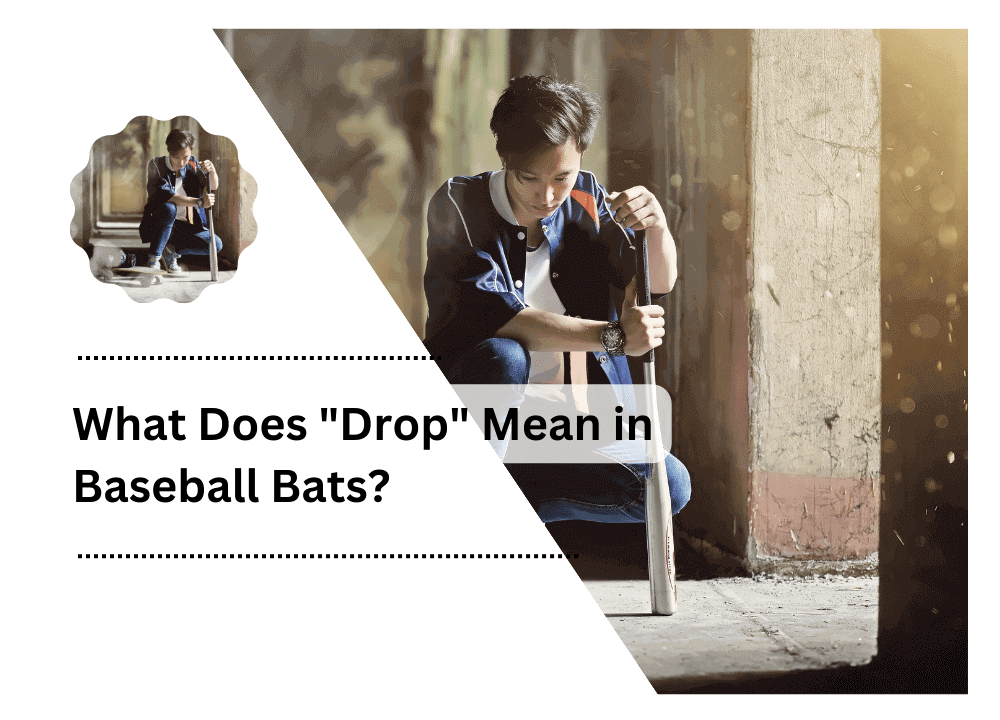
What does “drop” mean in baseball bats? In the world of sports, especially baseball, understanding the terminology is crucial and important. The term “drop” confuses players and enthusiasts new to baseball. This blog post will explore the meaning of “drop” in baseball bats and why it is significant to choose the right bat for a game in a way that aligns with the player’s age, league requirements, and hitting style.
Understanding Drop in Baseball Bats
The difference between the bat weight and bat length is the ‘drop’ or ‘drop weight’ of a baseball bat. Suppose the length of your bat is 30 inches from tip to tip, and the weight is 20 ounces; then it is a drop 10 or -10 bat.
In order to calculate the drop, subtract the weight of the bat in ounces from the length of the bat in inches. For example, if a bat is 35 inches long and weighs 25 ounces, the drop would be -10. The simple formula to calculate a bat’s weight is as follows:
Drop Weight = [Bat’s length (in inches) – Bat’s weight (in ounces)]
The resulting drop value is a negative number because the bat’s weight is less than its length. Drop values, along with other specifications like model, material, and certification, are mostly labeled on the bat by manufacturers.
Why Drop Matters in Baseball?
Now you know that a bat with a higher drop score is lighter and easier to swing. In contrast, a bat with a low drop score is heavier but allows players to hit with more power. Both bats have their pros and cons, but typically, drop 3 bats are preferred as they allow players to refine their skills rather than rely on the bat’s qualities.
The following factors influence bat drop selection, and therein lies its importance:
Age and Regulations
There are different drop requirements for various age groups and leagues. If you’re starting as a young player, a bat with a higher drop weight, like -10 or -12, could be a good choice for you as they are easy and light to swing, thus helping you generate more bat speed and control. As you become experienced, you would switch to a bat with a lower drop weight, like -5 or -3 (BBCOR). Such bats are heavier and offer more power and hitting distance.
| Age | Bat Drop |
| 10-12 | -10 |
| 12-13 | -8 |
| 10 and under | -11 |
| 13-14 | -5 |
| High School and College | -3 |
Player’s Hitting Style and Strength
Preference for a bat also depends on the style of hitting. Every player has their own hitting style and strength. Power hitters prefer bats with lower drop (-3 to -5) as it increases the momentum and distance of the ball when it makes contact and also adds more mass to the swing. Contact hitters go for high drop value (-8 to -10) bats to increase maneuverability and bat speed, thus improving bat control.
Bat Length and Weight Distribution
According to the definition, the ideal drop for a player is mostly determined by the bat length and weight distribution. Longer bats swing more forcefully, whereas shorter bats are more manageable. If you want to achieve a comfortable, efficient swing that is in accordance with your hitting technique and also fits your physique, it is necessary to search for the right balance between bat length and weight distribution.
Balancing Between Power and Control
A player’s ability to generate speed, hit the ball, and control the swing are affected by the drop weight. The right drop value also hits a balance between power and control. A heavier bat with a lower drop offers more power but trades some control lighter, whereas a higher drop bat provides more bat control at the expense of power. To find the perfect mix that supports performance objectives, you should monitor your skill level and priorities.
Exploring Different Drop Options
Frequently preferred drop numbers are -3, -5, and -10, each accounting for a particular ratio of weight to length.
What are the Various Drop Values? (e.g., -3, -5, -10)
Drop Value -3:
- A Bat with a length-to-weight ratio of -3 has a drop value of -3.
- It is most commonly used in high school and college baseball.
- Also known as BBCOR, they ensure safety and performance standards.
Drop Value -5:
- Bat with a length-to-weight ratio of -5. These bats are lighter than -3 bats.
- It is used in youth leagues and also in some middle school divisions, allowing young players to handle a lighter bat while transferring to heavier models.
Drop Value -10:
- Bat with a length-to-weight ratio of -10. These bats are lighter than both -3 and -5 bats.
- It is commonly used in youth baseball, especially for players who are just starting out the game, as it helps to generate bat control and speed.
Pros and Cons of Different Drop Values
Drop Value -3:
Pros:
- Suitable for high school and college play.
- Provides more power because of the higher bat weight.
Cons:
- It is challenging to control for less experienced players.
- This leads to slower swing speeds for some players.
Drop Value -5:
Pros:
- Better balance between power and control.
- They are easier to handle as compared to -3 bats.
Cons:
- Do not provide the same power as -3 bats.
Drop Value -10:
Pros:
- It is much lighter in weight, rendering swing easier.
- Aids in quicker bat speed and improved control.
Cons:
- Offers less power as compared to heavier bats.
- Not preferable for high school or college because of the drop restrictions.
Which Drop is Suitable for Different Positions in Baseball? (e.g., Power Hitters, Contact Hitters)
Power Hitters:
They prefer bats with a lower drop, such as -3, as these bats provide more mass and aid them in generating greater power in hitting the ball. Longer distances and harder hits are made due to extra weight.
Contact Hitters:
These may choose bats with a higher drop, like -5 or -10, to maximize their bat speed and control. These lighter bats help them to make quick and precise swings and also focus on building consistent contact with the ball.
How to Choose the Right Bat Drop?
Assessing Personal Preferences and Needs:
- Comfort and Confidence: A more natural drop, providing better performance in practice, is the right choice.
- Playing Level: There are specific bat drop requirements for different leagues and age groups, so it is important to check these rules.
- Player’s Age and Strength: Lighter bats with higher drops are suitable for young and less experienced, and the reverse is true for older and stronger players.
- Position and Playing Style: Power hitters prefer heavier bats for more distance, whereas contact hitters go with lighter bats for better control and bat speed.
Consulting with Coaches or Experts:
- Talk to Coaches: Coaches possess valuable insights into a player’s strengths and weaknesses. Their guidance in selecting the appropriate bat drop is based on the player’s skills and position.
- Seek Expert Advice: Consider visiting a local sports store or consulting experienced baseball/softball experts. Their recommendations are based on their knowledge. Moreover, they can also analyze a player’s swinging mechanics, i.e., style and technique.
Trying Out Different Bats and Finding the Right Balance
Visiting a sports goods store and swinging different bats with variable bat drops helps to see which one is more effective and comfortable.
- Bat Demo Days: These days are hosted by many sporting goods stores and manufacturers where you can try out different bats.
- Bat Swinging: Swing different bats to test how they feel during practice swings. Monitor bat speed, comfort, and control. A bat that feels balanced and offers easy control is good to go.
- Hitting in Live Practice: Take a few swings with different bats in a batting cage or live practice sessions. This will help you to analyze the bat’s performance at the time of hitting real pitches.
- Feedback from Teammates: Teammates’ experiences with different bat drops provide noticeable insights.
- Consider the “Sweet Spot”: Different bat drops affect the size and location of the bat’s sweet spot. A bat with a comfortable and effective sweet spot is important for consistent hitting.
Conclusion for What Does “Drop” Mean in Baseball Bats?
Bat drop is a numerical value showing the difference between a bat’s length (in inches) and weight (in ounces). It is expressed as a negative number (e.g., -3, -5, -10). It affects player performance, including bat speed and control, ensuring compliance with age and league regulations. Moreover, it aligns with a player’s hitting style and comfort level.
Selecting the right bat drop is an important decision in baseball. It directly affects the performance of the player and also the enjoyment of the game. Therefore, it is considered necessary to research, consider your goals, seek guidance, and try before buying a bat.
Understanding the term “bat drop” in detail is much more than a technical aspect of the game; it plays a basic role, both for power hitters and contact hitters, in influencing success, achieving goals, and enjoyment on the field. We hope this article provided you with a comprehensive understanding of what drop means in baseball bats and how it affects you as a player.
